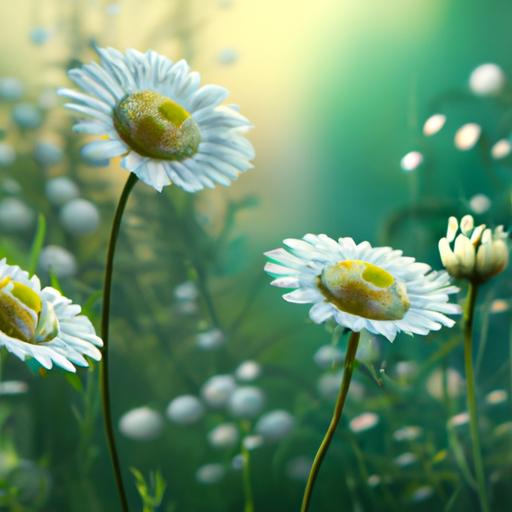The daisy is one of natures most beloved flowers, but have you ever stopped to wonder if a daisy is truly wild or not? In this article, well be taking a closer look at the history, symbolism, botanical characteristics, edible qualities, different types, and uses of the daisy in order to uncover the truth.
Well also explore how to grow daisies in gardens, so you can enjoy the beauty of these flowers for yourself.
By the end of this article, youll have a better understanding of the daisy and the role it plays in our lives.
Table of Contents
Short Answer
Daisy is not a wild flower, but it is a cultivated species that has been bred for garden use.
It is a member of the Asteraceae family, and the species name is Bellis perennis.
Daisies have been grown for centuries and can be found in a variety of colors and sizes.
They are popular garden flowers and are often used in bouquets and other floral arrangements.
The History of the Daisy
The daisy has a long and fascinating history.
It has been a symbol of innocence and purity since ancient times, and is even mentioned in the Bible.
The Latin word for daisy is “bellis perennis,” which translates to “everlasting beauty.” Daisies have been used as a medicinal herb for thousands of years, and were believed to have healing properties.
They were also used in many traditional religious ceremonies.
The daisy is a member of the Asteraceae family, which includes over 20,000 species of plants.
The daisy, or Bellis perennis, is native to Europe, Asia, and North America.
It is a hardy plant that can thrive in a variety of habitats, from meadows and fields to gardens and parks.
The daisy is an iconic flower, with its bright white petals and yellow center.
It is a popular flower for bouquets, and is often used in weddings and other special occasions.
Daisies are also edible, and have a mild, sweet flavor.
The daisy is an enduring symbol of innocence and purity, and is beloved by many.
It is no wonder that it has been a popular flower for centuries, and will continue to be so for many years to come.
Symbolism of the Daisy

The daisy is a beloved symbol of innocence and purity, making it a popular flower for bouquets, gifts, and other decorative arrangements.
Its bright white petals and yellow center make it a cheerful and optimistic symbol, representing hope and joy.
The daisy is also associated with loyalty, faithfulness, and new beginnings, as well as being a symbol of eternal love.
The flower is often used to express sympathy and condolences, as its simple beauty can help to bring comfort to those who are grieving.
In addition to its symbolism, daisies are also edible, with a mild, sweet flavor that can be enjoyed in salads and other dishes.
Botanical Characteristics of the Daisy
The daisy is a small flower with a white and yellow center, and is a member of the Asteraceae family.
It grows wild in fields and meadows, and is often seen in gardens.
The daisy has a simple flower head composed of a central, yellow disc, surrounded by white petals.
The petals are usually arranged in two rows, with the inner row having slightly longer petals than the outer row.
The daisy can grow to between five and 10 inches in height, and has a shallow, fibrous root system.
The daisy is an annual or biennial plant, and blooms in spring or summer.
The flower head consists of a central receptacle, filled with numerous small florets.
The florets can be yellow, white, or a combination of both.
The daisy has very few leaves, which are usually linear and narrow.
The daisy is a very hardy plant, and can survive in a wide range of soil types and climates.
It can grow in full sun or partial shade, and prefers moist, well-drained soil.
The daisy is also relatively drought tolerant, and can survive periods of low water availability.
The daisy is a hardy plant, and can survive in areas with temperatures as low as -20F.
Edible Qualities of the Daisy

The daisy is an edible flower with a mild, sweet flavor that makes it an ideal addition to salads, desserts, and drinks.
Its petals have a pleasant crunch when eaten, and its slightly tart center adds a unique flavor to any dish.
Its also a great source of vitamins and minerals, including vitamin A, vitamin C, and calcium.
In addition to its flavor and nutritional value, the daisy is also known for its medicinal qualities.
It has been used to treat various ailments, including headaches, stomachaches, skin irritation, and sore throats.
Daisies are also thought to have antiseptic and anti-inflammatory properties.
When enjoying the daisy, be sure to pick it from a safe area, away from any chemical runoff or other pollutants.
Its best to leave the flower in its natural habitat, as it can be easily damaged by handling and transporting.
The petals should be carefully removed before eating, as they are often covered in small thorns.
When it comes to preparing the daisy, the possibilities are endless.
The petals can be added to salads, soups, and smoothies, or blended into a paste and used as a spread.
The daisy is also popularly used as a garnish for dishes such as fish, chicken, and vegetables.
It can also be made into a tea, used in baking, or even dried and used as a decorative element.
The daisy is a beloved edible flower that is sure to add flavor, texture, and color to any dish.
With its mild, sweet taste and abundant health benefits, the daisy is a great choice for any culinary adventure.
Different Types of Daisies
When it comes to daisies, there is more than meets the eye.
While the flower may look similar at first glance, there are actually many different types of daisies that can be found in nature.
From the classic English Daisy to the larger Shasta Daisy, there is a variety of different species of daisy that is sure to delight any flower enthusiast.
The English Daisy (Bellis perennis) is perhaps the most recognizable species, and is known for its small white and yellow flowers with a yellow center.
This species is a perennial plant that can be found growing wild in meadows and fields all over Europe.
It is often used in bouquets as a symbol of innocence and purity.
The other well-known species of daisy is the Shasta Daisy (Leucanthemum x superbum).
This species is larger than the English Daisy, and has white petals with a yellow center.
It is a popular garden plant, and is often used as a cut flower in bouquets.
Other species of daisy include the Oxeye Daisy (Leucanthemum vulgare), the Gerbera Daisy (Gerbera jamesonii), and the African Daisy (Arctotis acaulis).
All of these species are members of the Asteraceae family, and have similar characteristics.
In addition to their beauty, many species of daisies are also edible.
While they may not be the most flavorful flowers, they do have a mild, sweet taste that can be used in baking or as a garnish for salads.
So, is Daisy a wild flower? The answer is yes! Daisies can be found growing wild in meadows and fields all over the world, and many species are also popular as garden plants.
They are a symbol of innocence and purity, and can be used in bouquets or as edible flowers.
With so many different species of daisies, it’s no wonder they are such a popular flower.
Growing Daisies in Gardens

Gardening enthusiasts around the world have been growing daisies in their gardens for centuries, thanks to their bright and cheerful colors and easy maintenance requirements.
Daisies are versatile and can be grown in full sun, partial shade, or even indoors.
The white petals with a yellow center of the daisy can create a stunning contrast against other blooms in a garden, or can be used to add texture and form to a flower bed.
Daisies are hardy flowers and can thrive in a variety of soil types, from sandy loam to clay.
They are drought tolerant, making them an ideal choice for dry climates, and can also handle a variety of temperatures.
When planting daisies, it is important to ensure they are planted in an area with good drainage, as they will not tolerate wet feet.
Daisies are relatively low maintenance and can even be grown from seed.
When planted in a sunny area, they will require regular watering and fertilizing to ensure they thrive and produce the best blooms.
Deadheading is also important, as it will encourage the daisy to keep producing new flowers.
Uses of Daisies
Daisies have been used for centuries in various ways.
They have been used as decorations, given as gifts, and even used as medicinal remedies.
In some cultures, daisies are said to bring good luck and are used as talismans.
Daisies have also been used in fashion, as their petals have been used to create clothing and jewelry.
Daisies are also edible and can be used in recipes for salads, teas, and other dishes.
Their mild, sweet flavor makes them a popular addition to many dishes.
Daisies are also popular as a source of nectar for bees, and are often planted in gardens to attract them.
Daisies have also been used as a symbol of innocence and purity, and are often seen as a part of wedding bouquets.
They are also seen as a symbol of unrequited love, and can be found in many romantic poems and songs.
Final Thoughts
From its historical roots to its many uses today, the daisy is a flower that has been around for centuries.
Its delicate beauty and symbolism of innocence and purity make it a popular choice for bouquets and garden decorations.
Its edible qualities, along with its varied types and easy cultivation, make the daisy a versatile and desirable flower.
Consider adding daisies to your garden or next floral gift to share the beauty and history of this timeless flower.

